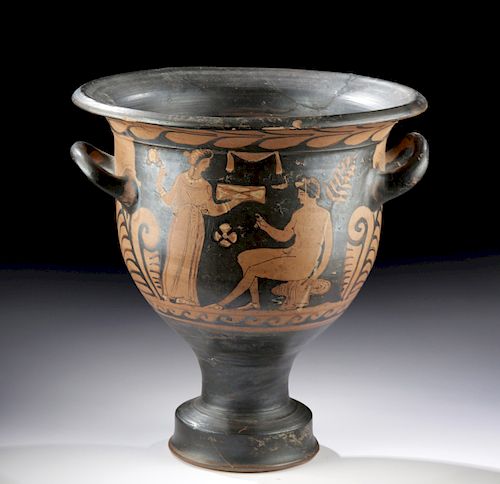Apulian Red-Figure Bell Krater - Dionysos & Maenad
Lot 36b
About Seller
Artemis Fine Arts
686 S Taylor Ave, Ste 106
Louisville, CO 80027
United States
Selling antiquities, ancient and ethnographic art online since 1993, Artemis Gallery specializes in Classical Antiquities (Egyptian, Greek, Roman, Near Eastern), Asian, Pre-Columbian, African / Tribal / Oceanographic art. Our extensive inventory includes pottery, stone, metal, wood, glass and textil...Read more
Estimate:
$12,000 - $18,000
Absentee vs Live bid
Two ways to bid:
- Leave a max absentee bid and the platform will bid on your behalf up to your maximum bid during the live auction.
- Bid live during the auction and your bids will be submitted real-time to the auctioneer.
Bid Increments
| Price | Bid Increment |
|---|---|
| $0 | $25 |
| $300 | $50 |
| $1,000 | $100 |
| $2,000 | $250 |
| $5,000 | $500 |
| $10,000 | $1,000 |
| $20,000 | $2,500 |
| $50,000 | $5,000 |
| $100,000 | $10,000 |
| $200,000 | $20,000 |
About Auction
By Artemis Fine Arts
Sep 26, 2019
Set Reminder
2019-09-26 10:00:00
2019-09-26 10:00:00
America/New_York
Bidsquare
Bidsquare : Exceptional Day 1: Antiquities & Asian Art
https://www.bidsquare.com/auctions/artemis-gallery/exceptional-day-1-antiquities-asian-art-4437
Day 1 of an important 2-day auction featuring exceptional, museum-worthy examples of Egyptian, Greek, Etruscan, Roman, Viking, Russian, Near Eastern, as well as Asian Art from China, Japan, Thailand, Vietnam, Burma and India. Artemis Fine Arts info@artemisgallery.com
Day 1 of an important 2-day auction featuring exceptional, museum-worthy examples of Egyptian, Greek, Etruscan, Roman, Viking, Russian, Near Eastern, as well as Asian Art from China, Japan, Thailand, Vietnam, Burma and India. Artemis Fine Arts info@artemisgallery.com
- Lot Description
Magna Graecia, Southern Italy, Apulia, ca. 350 to 300 BCE. An enormous Apulian bell krater (wine mixing vessel), its generous surface area extensively painted via the red-figure technique with added fugitive yellow/white pigment - featuring Dionysian (Bacchic) scenes, quite apropos for this wine-drinking vessel. Side A presents a feminine maenad, draped in a flowing garment and bedecked with armlets, a beaded necklace, and drop earring as well as a saccos over her upswept coiffure. She stands in composite profile holding a box/cask in her outstretched left hand (presenting it to young Dionysos) and a mirror to emphasize her femininity in her raised right hand. Seated before her is a nude male, perhaps a young Dionysos, his cloak serving as a cushion upon the rock upon which he sits, holding a wreath in his raised right hand and a thyrsus in the crook of his left arm. Side B features a pair of opposing draped figures flanking a stylized palmette. Size: 9.875" W handlespan x 10.875" H (25.1 cm x 27.6 cm)
In addition to this figural iconography, the decorative program is quite impressive, featuring stylized composite palmettes beneath each handle, a grand laurel leaf garland adorning the underside of the rim, and a register of wave motifs below the figural scenes and palmettes.
Perhaps the most exciting innovation in Greek vase painting was the red-figure technique, invented in Athens around 525 BCE and beloved by other artists of Magna Graecia. The red-figure technique allowed for much greater flexibility as opposed to the black-figure technique, for now the artist could use a soft, pliable brush rather than a rigid metal graver to delineate interior details, play with the thickness of the lines, as well as build up or dilute glazes to create chromatic effects. The painter would create figures by outlining them in the natural red of the vase, and then enrich these figural forms with black lines to suggest volume, at times perspectival depth, and movement, bringing those silhouettes and their environs to life. Beyond this, fugitive pigments made it possible for the artist to create additional layers of interest and detail as we see in this example.
Provenance: private Los Angeles, California, USA collection owned for almost two decades
All items legal to buy/sell under U.S. Statute covering cultural patrimony Code 2600, CHAPTER 14, and are guaranteed to be as described or your money back.
A Certificate of Authenticity will accompany all winning bids.
We ship worldwide and handle all shipping in-house for your convenience.
#149944Several pieces reattached to the rim and foot reattached. Pressure crack at interior base. Possible repairs to body though if so, these are difficult to see. Normal surface wear with minute nicks, scuffs, and slight pigment loss, but much remains. Deposits grace the surface and black glaze has developed a silvery iridescence in areas. Old collection label on underside of foot.Condition
- Shipping Info
-
All shipping is handled in-house for your convenience. Your invoice from Artemis Gallery will include shipping calculation instructions. If in doubt, please inquire BEFORE bidding for estimated shipping costs for individual items.
-
- Buyer's Premium



 EUR
EUR CAD
CAD AUD
AUD GBP
GBP MXN
MXN HKD
HKD CNY
CNY MYR
MYR SEK
SEK SGD
SGD CHF
CHF THB
THB
















